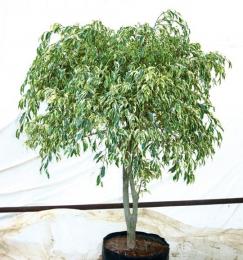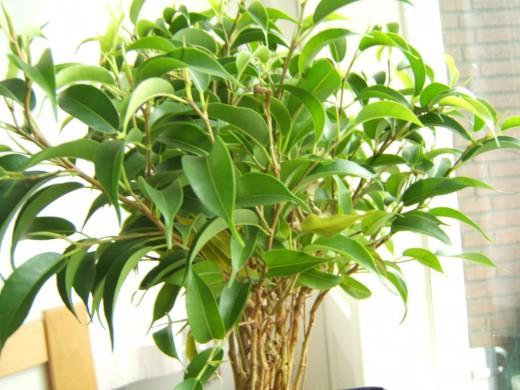Ficus benjamina: care, transplantation, reproduction

Ficus benjamina belongs to the mulberry family and its decorative species can reach up to two meters. You may not see flowering often, but the oblong-oval glossy leaves are the main advantage of this small tree. The name Benjamin comes from the benzoin resin found in the sap of the plant.
Content:
Rules of care and choice of location
Ficus is quite unpretentious, but many people mistakenly believe that it needs special care, since it can suddenly drop its leaves or stop growing. However, this is far from true.. You just need to follow some rules and learn the little secrets of care technology.
Buy ficus better in a specialized store in spring or early summer. The plant must be young and at this time its rapid growth is underway. The leaves should not fall off.
This plant loves light, but placing it in direct sunlight is not recommended. There should be a lot of lighting, but the light is diffused.
Ficus Benjamin feels quite comfortable in the summer at a temperature of 25 degrees, and in winter fifteen is enough. Some varieties can withstand even ten degrees of heat.
The biggest danger lies in drafts, which the plant simply cannot tolerate. Therefore, you should not place it near the balcony door, air conditioner or radiator. A bright, quiet corner will be the best place.In this case, there is no need to turn the pot once again or rearrange it.
It is important to achieve the desired humidity, which should be 60-70 percent. You need to spray the leaves twice a day, and take a “shower” with warm water once a month. To do this, the ficus is transferred to the bath. cover the ground with film and wash with settled water. Only after the leaves have dried are they returned to their place.
Water the plant it is necessary when the soil dries out by one fifth after the previous watering, but does not dry out. Settled boiled water is used and fertilizers are periodically added to it. Watering is carried out in small portions for an hour and then the excess water is drained.
In order for the transplant done on Ficus Benjamin to be successful, certain conditions must be met.
Ficus transplant

The fact is that replanting the plant will be simply necessary, as the young ficus is growing. As soon as the roots appear through the drainage holes, and the time between watering is reduced, you need to start replanting.
Each new pot should be at least two or three centimeters larger than the previous one. Until the age of five, the ficus is replanted every year, and then after two years. For a large plant, only partial replacement of the soil can be done.
During transplant procedures The ficus must be removed from the old pot very carefully so as not to damage the root system.
In a new container you need to lay a layer of expanded clay, and then earth. All that remains is to place the plant and fill in the substrate. The soil on the sides can be compacted a little and then watered.
It is also better to transplant in spring or summer, as this is the most favorable time. It is advisable to water the soil generously two days before to make it easier to remove the ficus from the pot.
Plant propagation
Many are also interested in the issue related to the propagation of this tropical plant. Moreover, it is better to propagate Ficus Benjamin in the spring and summer.
Cuttings are best suited for this. The top of the plant is used. Using a sharp knife, you need to carefully cut off a twig that has five to seven leaves. It should be fairly woody and not too soft. The size of the cutting does not exceed ten centimeters.
During the preparation process, it is necessary not only to wipe off the milky juice that appears, but also to put in cuttings and water, which will need to be changed several times during the day. Only after completely getting rid of the juice should you put the cuttings back into the water and after two weeks small roots will appear.
They can also be grown in peat or using special tablets. To do this, the cutting is stuck to a depth of one and a half centimeters and then covered so that greenhouse conditions can be created. Small roots will appear after three to four weeks.
It is better to tear off the lowest leaves and replant them in small pots with a diameter of no more than ten centimeters. Expanded clay is also placed on the bottom and almost any soil can be used.
When the tree begins to grow, you can shape the crown according to your desire and taste. To make it lush, you just need to remove the side shoots and pinch them after reaching a certain height. You can form a ball or other fancy shape by trimming. Only it should be carried out at the end of winter, so as not to be combined with a transplant.
Reproduction of ficus does not present any particular problems, but it is important to create comfortable conditions for it all the time and ensure that pests do not infest and the plant does not get sick.
Diseases and pests

Ficus benjamina is susceptible to various diseases. They are mainly of bacterial or fungal origin:
- Fungal diseases may cause yellow, brown or black spots to appear on the leaves. They need to be torn off and the plant treated with preparations that contain copper.
- Bacterial diseases, unfortunately, cannot be treated and the plant will have to be destroyed.
- Among the ficus pests, the spider mite is the most annoying. This affects photosynthesis. It must be removed with a damp swab and acaricides applied.
- Mealybug causes sheets to curl and stain. It will require an insecticide.
- Similar symptoms may be a sign of aphids. The plant stops growing and entire clusters of pests can be found. They are combated using insecticides or a solution of laundry soap. Seventeen grams per liter of water is enough.
- Sometimes leaves may dry out and fall due to insufficient moisture. Therefore, you can simply spray.
- If there is not enough heat, the leaves quickly wither and curl. Lack of light also has a negative effect. But these problems are easy to solve.
Ficus benjamina is ideal for the home. Simple rules of care, fertilizing and timely pruning of the crown will allow you to grow a plant that will delight you with its beautiful green leaves for many years and may even bloom.
Quick and easy propagation of Ficus Benjamin on video:
Interesting information about the vegetable garden










